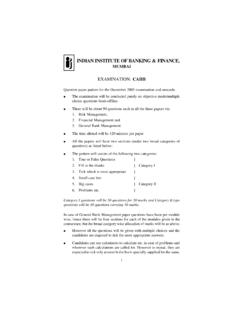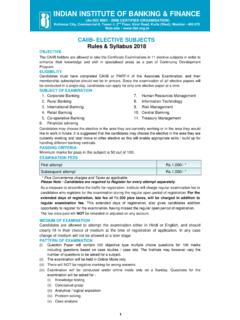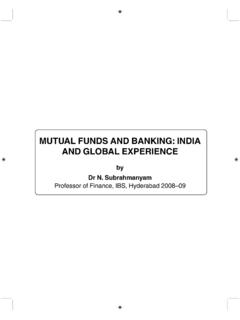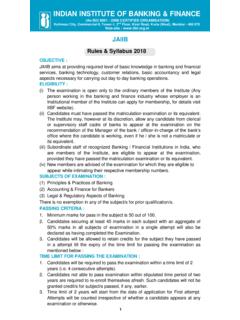Transcription of 1. GUIDELINES (GENERAL) - IIBF
1 IMPORTANT GUIDELINES ON guarantees and co -ACCEPTANCES * ( general ) Bank Guarantees (BG) comprise both performance guarantees (PG) and financial guarantees (FG) and are structured according to the terms of agreement viz., security, maturity and purpose. Banks should confine themselves to the issuance of FG and exercise due caution with regard to PG business. Bank guarantees should not normally extend beyond 10 years. Banks may issue guarantees (BG) for periods beyond 10 years taking into account the impact of very long duration guarantees on their Asset Liability Management and in tune with their policy on issuance of guarantees beyond 10 years as approved by the GUIDELINES for unsecured advances & guarantees Banks Boards have been given the freedom to fix their own policies on their unsecured exposures including unsecured guarantees.
2 Unsecured exposure is where the realizable value of the tangible security, as assessed by bank/approved valuers/RBI inspecting officers, is not more than 10% ab-initio, of the outstanding exposure (funded and non-funded exposure including underwriting and similar commitments). The rights, licenses, authorizations, etc. are not reckoned as tangible security whereas annuities under Build-operate-transfer (BOT) projects and toll collection rights where there exists provision to compensate the project sponsor if a certain level of traffic is not achieved can be treated as tangible security.
3 For issuing guarantees Avoid giving unsecured guarantees in large amounts for medium and long-term periods and such commitments to particular groups of customers and/or trades. For individual constituent, unsecured guarantees should be limited to a reasonable proportion of the bank s total unsecured guarantees and constituent s equity. The BG exposure on behalf of any individual constituent or group is subject to the prescribed exposure norms. Not to encourage parties to over-extend their commitments as the BG contains inherent risks. Banks can give deferred payment guarantees on an unsecured basis for modest amounts to first class customers in exceptional for Averting Frauds While issuing FGs, banks should satisfy about customer s ability/capacity to reimburse the bank in case it is required to honor the commitments under the FG.
4 In case of PG, banks should exercise due caution and satisfy themselves that the customer has the necessary experience, capacity and means to perform the obligations under the contract, and is not likely to commit any default. Banks should refrain from issuing BGs on behalf of customers who do not enjoy credit facilities with them other than customers of co-operative banks against counter guarantee of the co-op. bank which have sound credit appraisal and monitoring systems as well as robust Know Your Customer (KYC) Committee Recommendations (Shri A. Ghosh, the then Dy.)
5 Governor, RBI)a)BGs should be issued in serially numbered security forms;b)While forwarding the BGs to the beneficiaries, caution them to verify the genuineness of the guarantee with the issuing bank. Control Systems BGs for Rs. Lakh and above are to be signed by two officials jointly. A lower cut-off point, depending upon the size and category of branches, may be prescribed by banks, where considered necessary. Allow deviation from the two signatures discipline should be only in exceptional circumstances. In such cases there should be a system for subjecting such instruments to special scrutiny by the auditors or inspectors at the time of internal inspection of branches.
6 On behalf of Banks' Directors In view of the possibility of contingent liability becoming a funded liability in case of invocation, Banks should, while extending non-fund based facilities such as BGs, etc. to the directors or the constituents in which they are interested, ensure that: a)Adequate and effective arrangements are in place to honor the commitments out of their own resources by the party on whose behalf guarantee was issued, andb)The bank will not be called upon to grant any loan or advance to meet the liability, consequent upon the invocation of guarantee .
7 guarantee Scheme of Government of India BGs are to be issued in the Model Form of Bank guarantee Bond and in favour of Govt. departments in the name of President of India and any correspondence thereafter should be exchanged with the concerned departments only. In respect of BGs favouring the Director general of Supplies and Disposal (DGSD), the following aspects to be kept in view:- a)In order to expedite the process of verification of genuineness of the BGs, name, designation and code numbers of the signatory should be incorporated under their signature therein;b)The beneficiary of the bank guarantee should also be advised invariably to obtain the confirmation of the concerned banks about the genuineness of the guarantee issued by them as a measure of safety.
8 C)The initial period of the BG issued by banks as a means of security under DGSD would be for a period of six months beyond the original delivery period with suitable clause providing automatic extension of the validity period by 6 months. Bank may obtain suitable undertaking from the customer at the time of establishing the guarantee to avoid any possible complication later. d)Like the tender form floated by DGSD, the Public Notice issued by the Customs Department stipulates, inter alia, that all BGs furnished by an importer should contain a self renewal clause inbuilt in the guarantee itself.
9 Hence, BGs issued in favour of DGSD and Customs Houses should invariably contain suitable clause for automatic extension of the guarantee period on Behalf of Share and Stock Brokers/ Commodity Brokers Banks can issue BGs on behalf of share and stock brokers in favour of Stock Exchanges towards security deposit, margin requirements as per Stock Exchange Regulations. BGs can also be issued on behalf of commodity brokers in favour of national level commodity exchanges viz. National Commodity & Derivatives Exchange (NCDEX), Multi Commodity Exchange of India Limited (MCX) and National Multi-Commodity Exchange of India Limited (NMCEIL), in lieu of margin requirements as per the Commodity Exchange Regulations.
10 Banks are required to obtain a minimum margin of 50% (out of which cash margin to be 25%) while issuing such guarantees in both the above cases and to observe usual and necessary safeguards including the exposure ceilings. Personal guarantees of directors Obtaining the personal guarantees of directors by banks for credit facilities, etc. granted to corporate, public or private, should be only when the same is absolutely warranted and should not taken as a matter of course. In order to identify the circumstances under which the guarantee may or may not be considered necessary, banks are required to follow the GUIDELINES as under:- a)Obtaining the guarantee not considered necessary In case of public limited companies, the lending institutions are satisfied about the management, economic viability, stake in the concern, financial position, cash generation, etc.










